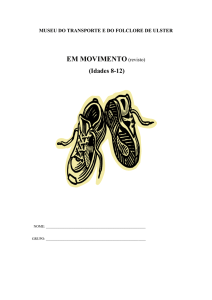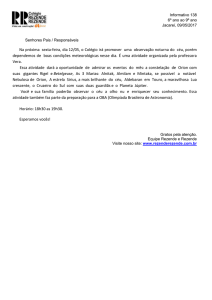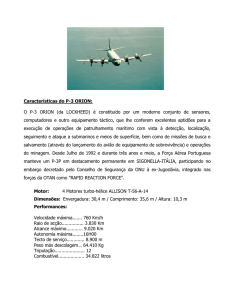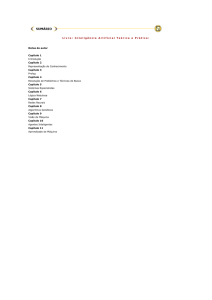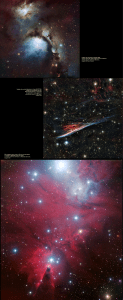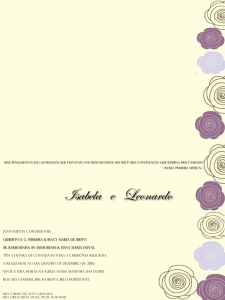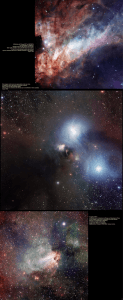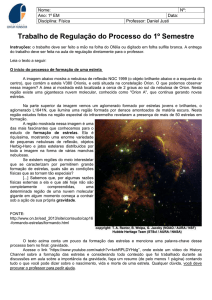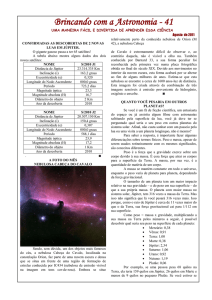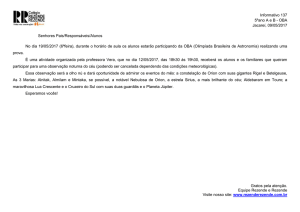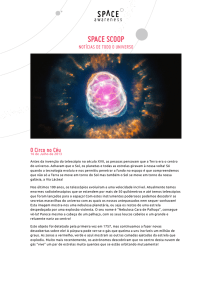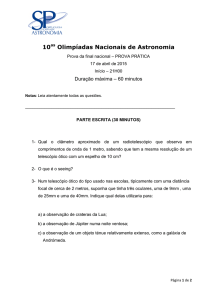a primeira fotografia de uma nebulosa
Propaganda
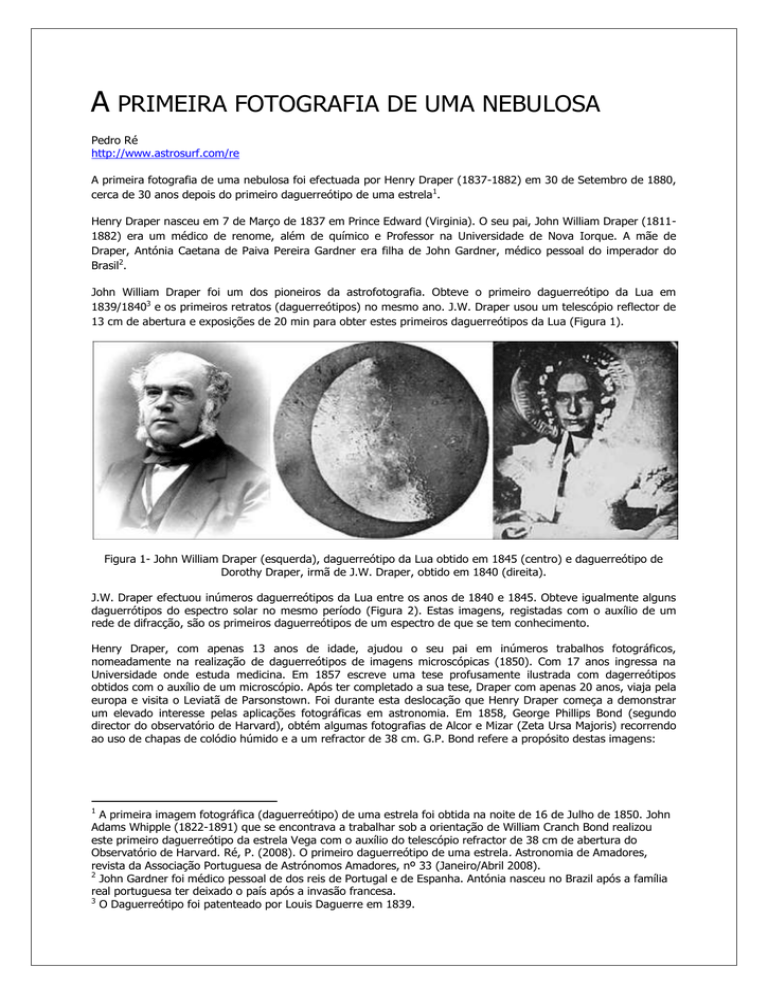
A PRIMEIRA FOTOGRAFIA DE UMA NEBULOSA Pedro Ré http://www.astrosurf.com/re A primeira fotografia de uma nebulosa foi efectuada por Henry Draper (1837-1882) em 30 de Setembro de 1880, cerca de 30 anos depois do primeiro daguerreótipo de uma estrela1. Henry Draper nasceu em 7 de Março de 1837 em Prince Edward (Virginia). O seu pai, John William Draper (18111882) era um médico de renome, além de químico e Professor na Universidade de Nova Iorque. A mãe de Draper, Antónia Caetana de Paiva Pereira Gardner era filha de John Gardner, médico pessoal do imperador do Brasil2. John William Draper foi um dos pioneiros da astrofotografia. Obteve o primeiro daguerreótipo da Lua em 1839/18403 e os primeiros retratos (daguerreótipos) no mesmo ano. J.W. Draper usou um telescópio reflector de 13 cm de abertura e exposições de 20 min para obter estes primeiros daguerreótipos da Lua (Figura 1). Figura 1- John William Draper (esquerda), daguerreótipo da Lua obtido em 1845 (centro) e daguerreótipo de Dorothy Draper, irmã de J.W. Draper, obtido em 1840 (direita). J.W. Draper efectuou inúmeros daguerreótipos da Lua entre os anos de 1840 e 1845. Obteve igualmente alguns daguerrótipos do espectro solar no mesmo período (Figura 2). Estas imagens, registadas com o auxílio de um rede de difracção, são os primeiros daguerreótipos de um espectro de que se tem conhecimento. Henry Draper, com apenas 13 anos de idade, ajudou o seu pai em inúmeros trabalhos fotográficos, nomeadamente na realização de daguerreótipos de imagens microscópicas (1850). Com 17 anos ingressa na Universidade onde estuda medicina. Em 1857 escreve uma tese profusamente ilustrada com dagerreótipos obtidos com o auxílio de um microscópio. Após ter completado a sua tese, Draper com apenas 20 anos, viaja pela europa e visita o Leviatã de Parsonstown. Foi durante esta deslocação que Henry Draper começa a demonstrar um elevado interesse pelas aplicações fotográficas em astronomia. Em 1858, George Phillips Bond (segundo director do observatório de Harvard), obtém algumas fotografias de Alcor e Mizar (Zeta Ursa Majoris) recorrendo ao uso de chapas de colódio húmido e a um refractor de 38 cm. G.P. Bond refere a propósito destas imagens: 1 A primeira imagem fotográfica (daguerreótipo) de uma estrela foi obtida na noite de 16 de Julho de 1850. John Adams Whipple (1822-1891) que se encontrava a trabalhar sob a orientação de William Cranch Bond realizou este primeiro daguerreótipo da estrela Vega com o auxílio do telescópio refractor de 38 cm de abertura do Observatório de Harvard. Ré, P. (2008). O primeiro daguerreótipo de uma estrela. Astronomia de Amadores, revista da Associação Portuguesa de Astrónomos Amadores, nº 33 (Janeiro/Abril 2008). 2 John Gardner foi médico pessoal de dos reis de Portugal e de Espanha. Antónia nasceu no Brazil após a família real portuguesa ter deixado o país após a invasão francesa. 3 O Daguerreótipo foi patenteado por Louis Daguerre em 1839. Figura 2- Daguerreótipo do espectro solar obtido por J.W. Draper (ca. 1840/1842). “There is nothing, then, so extravagant in predicting the future applications of photography on a most magnificent scale... What more admirable method can be imagined for the study of orbits of the fixed stars and for resolving the problem of their annual parallax?”. A maioria dos astrónomos contemporâneos de Bond e Draper não eram tão entusiasticos relativamente às aplicações fotográficas em astronomia. Agnes Clerke, célebre historiadora da astronomia no século XIX escreve em 18854 a propósito das imagens fotográficas obtidas por Bond: “...slight encouragement was derived from them, either to himself or others”. Henry Draper constroi um observatório astronómico em Hastings-on-Hudson equipado com um refractor de 11” (28 cm) e um reflector de 28” (71 cm) montados na mesma equatorial fotográfica. Publicou em 1864 uma extensa monografia sobre a construção de um telescópio reflector de 15,5” (39 cm) que constituiu uma referência essencial para todos os construtores de telescópios da época5 (Figura 3). O trânsito de Vénus ocorrido em 1874 constituiu uma excelente oportunidade para se usarem algumas técnicas fotogáficas no registo preciso deste importante acontecimento astronómico. Draper, era neste período, professor de fisiologia e director da Faculdade de Medicina de Nova Iorque tendo adquirido uma enorme experiência no registo fotográfico de diversos objectos celestes (Lua sobretudo) bem como no registo de espectros do Sol e das principais estrelas. Por este motivo, foi nomeado responsável pela secção fotográfica da equipa americana 4 Clerke, A. (1885). History of Astronomy in the Nineteenth Century. A. & C. Black, London. Draper, H. (1864). On the construction of a silvered glass telescope, fifteen and a half inches in aperture, and its use in celestial photography. Smithsonian Contributions to Knowledge. 5 destacada para observar o trânsito de Vénus. Apesar dos resultados obtidos não terem sido totalmente satisfatórios, Draper recebeu uma medalha de ouro atribuída pelo Congresso Americano pelo trabalho desenvolvido na preparação das observações fotográficas. Figura 3- Henry Draper (esquerda), observatório (centro) e monografia sobre a construção de telescópios reflectores (direita). Após o trânsito de Vénus, a grande maioria das fotografias astronómicas foram realizadas sobretudo por astrónomos amadores6. É exactamente neste período que Draper realiza as primeiras imagens de uma nebulosa. A utilização do colódio húmido impedia a realização de exposições longas uma vez que as placas secavam rapidamente. Draper visita William Huggins no seu observatório situado na periferia de Londres e utiliza pela primeira vez placas de gelatino-brometo de placa que tinham a vantagem se serem secas e mais sensíveis relativamente ao colódio húmido. Com o auxílio destas placas, Draper pode levar a cabo pela primeira vez as longas exposições necessárias para registar de um modo satisfatório imagens de nebulosas. Realiza assim a primeira fotografia da nebulosa de Orion (M 42) em 30 de Setembro de 1880. Escreve uma breve comunicação que envia para o American Journal of Science, onde refere muito poucos dados sobre esta primeira imagem. Draper usou o telescópio refractor de 11” e uma exposição de 50 min. Nesta mesma nota refere a sua intenção de: “(…) at an early date to publish a detailed description of the negative”. Apesar disso, Draper resolve publicar unicamente a imagem e não uma descrição técnica da mesma. As imagens foram impressas em cartão (dimensão aproximada da 15x15 cm) com a seguinte descrição: “First photograph of a nebula in Orion. Taken by Professor Henry Draper M.D.” (Figura 4). Draper nunca mencionou que tipo de emulsão (gelatino-brometo de prata) usou para obter esta primeira imagem apesar de ter referido várias vezes a elevada qualidade das chapas disponibilizadas pela firma Wratten & Wainwright. O facto de Draper nunca ter descrito de um modo pormenorizado esta primeira imagem pode estar relacionado com o facto de ter obtido pouco tempo depois uma imagem de melhor qualidade da mesma nebulosa com uma exposição de 104 min. Em Março de 1882, Draper efectua uma nova exposição da nebulosa desta vez com 137 min, que revela ainda mais pormenores. Esta imagem foi reproduzida (fotolitografia) por Edward Singleton Holden no final da sua importante monografia sobre a nebulosa de Orion7. A propósito destas imagens Draper escreve a Holden referindo: 6 Lankford, J. (1984). The impact of photography on astronomy. In The general history of astronomy, Vol. 4Astrophysics and twentieth-century astronomy to 1950: Part A. 7 Holden, E.S. (1882). Monograph of the Central parts of the Nebula of Orion. Washington Astronomical Observations for 1878 Appendix I. “The exposure of the Orion nebula required was 51 minutes; what do you think of that as a test of my driving clock?” Figura 4- Primeira fotografia de uma nebulosa (M 42) obtida por Henry Draper em 30 de Setembro de 1880. A exposição de 137 min (Figura 5) é descrita numa adenda à monografia de Holden: “ADDENDUM. PHOTOGRAPHIC RESULTS OF DR. HENRY DRAPER. The first photograph of the nebula of Orion was made by Dr. HENRY DRAPER in September, 1880, and the unavoidable delay which has occurred in printingthe present memoir enables me to include an account of the astonishing results which he has attained. A woodcut which I had prepared from his first photograph was found to be so unsatisfactory that Dr. DRAPER most generously offered to supply the necessary photolithographic reproductions of his last negative (taken March 14, 1882) to accompany the brief account I had prepared. (…) I requested Dr. DRAPER to prepare some account of his work to be presented with it, and I print below a memorandum which he has kindly furnished. Figua 5- Fotografia da nebulosa de Orion (Henry Draper, 137 min de exposição, refractor Clark 11”). "MEMORANDUM TO ACCOMPANY THE PHOTOGRAPH OF THE NEBULA IN ORION SENT TO PROFESSOR HOLDEN FOR HIS MEMOIR. BY HENRY DRAPER, M. D. As far as I know, no photograph of any nebula has been taken except in my observatory. The first photograph of the nebula in Orion was made on September 30, 1880, with my CLARK telescope of 11 inches aperture and an exposure of 51 minutes. It comprised the brightest parts of the region in the neighborhood of the trapezium and showed the condensed masses well. In March, 1881, a number of photographs of this object were taken, the best being on March 11 with an exposure of 104 minutes. By comparison with the former picture this made a marked advance, and minute stars down to the 14.7 magnitude of POGSON'S scale were shown. An account of it was read before the French Academy of Sciences and printed in the Comptes Rendus, April 18, 1881. On March 14, 1882, the negative was made from which the photolithographic enlargement in this memoir was produced. The instrument used was the CLARK telescope of 11 inches aperture mounted on the equatorial stand and driven by the clock which I had constructed. The exposure was from 7h 08m to 9h 25; that is, 137 minutes: gelatino-bromide plates were employed. The night was clear but cold and windy. The mean temperature was 27 Fahrenheit; the wind NNW and in gusts, the strongest pressure being 5 pounds per square foot about nine o'clock; the whole travel of the wind during the exposure was 35 miles. The variation in the force of the wind is one reason why the stars show some ellipticity under this magnifying power; the gusts of course displaced the telescope somewhat, though the mounting is firm and the clock-work strong. In the photograph the larger stars are much overexposed, the proper time to make a good picture of the trapezium being about 2 minutes. The twinkling of these stars is therefore recorded on the sensitive plate, and gives to them an excess of size. If a photograph should be taken on a steady night the stars of the trapezium would be easily separated, and in the original negative of this picture, in a strong light, the separation can be seen. The variation in size of the stellar images gives an idea of the relative magnitude of the stars, though that estimate requires correction for the color of the stars. It must be remembered that no one enlargement can do justice to the original negative; various exposures, various intensities of light, and various points of view are necessary for a complete examination. During the month of March, 1882, I also made four photographs of the spectrum of the nebula in Orion, which is described in the number of the American Journal of Science for May, 1882. Two of these were made with the slit spectroscope that I usually employ for photographing spectra of the stars and they show two lines in the ultra-violet plainly, beside the traces of two others. The first-mentioned two are hydrogen γ, λ 4340, and hydrogen 6, λ 4101; the others are too faint to give a good estimate of the wave length. The other spectrum photographs, taken without a slit, show that two of the condensed masses preceding the trapezium give a continuous spectrum, and, therefore, contain either gas under pressure, or liquid, or solid matter.271 MADISON AVENUE, New York, April 29, 1882”. Figura 6- Desenho da nebulosa de Orion efectuado por G.P. Bond com o refractor de 38 cm do observatório de Harvard Holden na referida monografia, descreve de um modo pormenorizado a maioria das observações (sobretudo visuais) efectuadas até 1882 da nebulosa de Orion. Subsistia a dúvida se a nebulosa apresentava alterações na sua forma e brilho. Holden refere a no final da sua monografia: “Although it is still too soon to give a final discussion to the photographic results attained by Dr. Draper, I cannot refrain from pointing out some of the conclusions which may be drawn from this marvelously perfect representation of the nebula. If we compare the engraving of G.P. Bond visual observation (Figura6) we shall be able best to appreciate the important advance which has been made. BOND'S engraving is the most accurate drawing that has been made, even as a map, and as a picture it is decidedly the best representation of a single celestial object which we have by the old methods. The work of observing alone extended over years and consumed many precious hours. I have before said how much labor was spent upon the mechanical execution of the steel plate; scores of revises were criticized and read. Dr. Draper's negative was made in 137 minutes, and for nearly every purpose is incomparably better than the other. The color and tint of the nebula, which is wonderfully preserved in BOND'S engraving, is lost in the photograph; and yet, if the latter is held up between the eye and a window, the pictorial effect is most striking. The amount of preparation for the two works is not to be estimated by years or hours, but it may be left out of account in a comparison. It required the best efforts of each observer to attain the results.” Draper pretendia realizar fotografias com um tempo de exposição superior. Com esta finalidade projecta uma montagem equatroial que lhe permitia atingir 6 h de exposição sem ter que inverter a posição do telescópio. Numa carta que escreve a E.S. Holdem refere: “I think we are by no means at the end of what can be done. If I can stand 6 hours exposure in midwinter, another step forward will result”. Infelizmente Draper morre em 1882 sem ter podido completer a nova montagem. A sua viuva estabelece em 1886 o “Henry Draper Memorial”. O refractor de 11” é enviado para o observatório de Harvard onde é utilizado para obter numerosas fotografias de espectros estelares. As imagens obtidas em 1883 por Andrew Ainslie Common (1841-1903) e por Isaac Roberts (1829-1904) em 1886 revelem um número muito mais elevado de pormenores na nebulosa de Orion (Figura 7). Common utilizou um teelscópio reflector de 91 cm de abertura e uma exposição de 60 min 8. Roberts recorreu a um reflector de 50 cm e a uma exposição de 90 min. Figura 7- Fotografias de nebulosa de Orion obtidas por A.A. Common (esquerda) e por I. Roberts (direita). A fotografia de Common foi incluída no fronstispício da obra de A. Clerck sobre a história da astronomia no século XIX. A propósito dos avanços proporcionados pela astrofotografia, esta autora menciona: “Photography may thereby be said to have definitively assumed the office of historiographer to the nebulae; since this one impression embodies a mass of facts hardly to be compassed by months of labor with the pencil, and affords record of stupendous object it delineates, which must prove invaluable to the students of its future condition”. Bibliografia Clerke, A. (1885). History of Astronomy in the Nineteenth Century. A. & C. Black, London. Draper, H. (1864). On the construction of a silvered glass telescope, fifteen and a half inches in aperture, and its use in celestial photography. Smithsonian Contributions to Knowledge. Holden, E.S. (1882). Monograph of the Central parts of the Nebula of Orion. Washington Astronomical Observations for 1878 Appendix I. Gingerich, O. (1980). The first photograph of a nebula. Sky and Telescope. November, 1980: 364-366. 8 As fotografias de Common mostram pela primeira vez mais pormenores e estrelas do que era possível observar visualmente com o mesmo instrumento.
